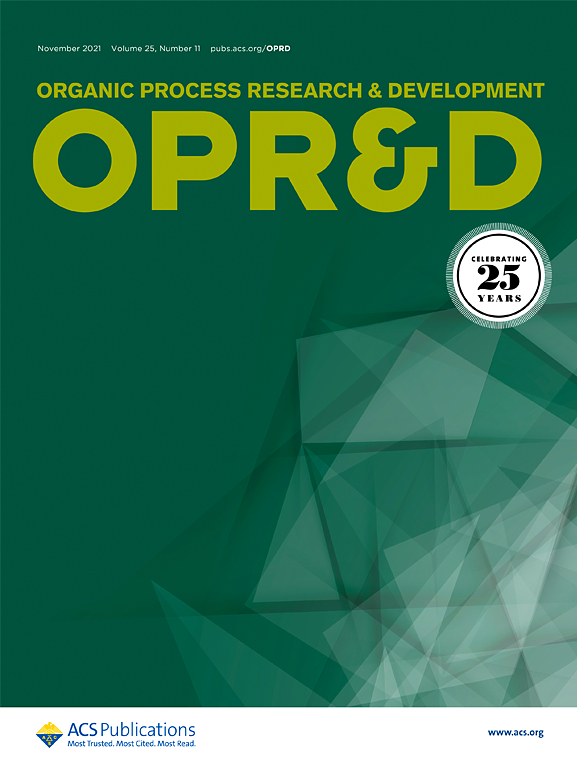基于人工智能图像识别的微乳液系统动态相分离自动高通量筛选平台的开发
IF 3.1
3区 化学
Q2 CHEMISTRY, APPLIED
引用次数: 0
摘要
正在加紧努力发展新的可持续生产工艺,均相催化在新的化学生产路线的选择性和能源效率方面具有许多优点。通常限制均相催化应用的一个主要因素是有价值的催化剂的保留。在有机反应中引入优异的反应性能和催化剂回收率的一个有希望的选择是在含有表面活性剂的水反应介质中使用水溶性催化剂。然而,这些基于表面活性剂的微乳液体系(MES)表现出复杂的相分离行为,这取决于各种参数,如温度和成分浓度,而由于复杂的热力学,目前无法预测其行为。因此,由于缺乏基本的建模方法,相行为的表征需要广泛而耗时的实验研究。为了方便实验数据的获取,本贡献提出了一个高通量筛选平台的开发,用于动态相分离分析,具有自动化实验程序,分离图像的人工智能分析和自动化结果数据处理。该平台能够快速表征MES分离行为,这是工艺开发和操作所必需的。筛选平台的功能在癸烯氢甲酰化的案例研究中得到了证明。使用Mask R-CNN模型进行图像检测,相位高度检测准确率为±1.5%,分类置信阈值为96%。新的设置可以快速评估超过722个测量运行,每个运行具有不同的分离温度和混合物组成组合,只需要总共38个手动给药步骤。收集到的数据还用于推导具有可解释机器学习的软传感器的相关性,从而可以在线洞察MES工厂中其他不可访问的过程变量,并使其可操作性。本文章由计算机程序翻译,如有差异,请以英文原文为准。

Development of an Automated High-Throughput Screening Platform for the Dynamic Phase Separation Analysis of Microemulsion Systems with AI Image Recognition
Increasing efforts are undertaken to develop new sustainable production processes, and homogeneous catalysis offers many advantages regarding selectivity and energy efficiency in new chemical production routes. A major factor often limiting the application of homogeneous catalysis is the retention of valuable catalysts. One promising option to introduce superior reaction performance and catalyst recovery in organic reactions is the use of water-soluble catalysts in aqueous reaction media with surfactants. However, these surfactant-based microemulsion systems (MES) exhibit a complex phase separation behavior that is dependent on various parameters such as temperature and component concentrations, while its prediction is currently not possible due to the complex thermodynamics. The characterization of the phase behavior hence requires extensive and time-consuming experimental investigation due to a lack of fundamental modeling approaches. To facilitate the acquisition of experimental data, this contribution presents the development of a high-throughput screening platform for dynamic phase separation analysis with an automated experimental procedure, AI analysis of separation images, and automated result data handling. The platform enables a fast characterization of MES separation behavior, which is required for process development and operation. The functionalities of the screening platform are demonstrated in a case study for the hydroformylation of decene. The image detection is performed with a Mask R-CNN model achieving a ±1.5% accuracy in phase height detection with a classification confidence threshold of 96%. The new setup enables a fast evaluation of over 722 measurement runs each with a different combination of separation temperature and mixture composition that only required at total of 38 manual dosing steps. The gathered data is also used to derive a correlation for a soft-sensor with interpretable machine learning, enabling online insights into otherwise inaccessible process variables in an MES plant and enabling its operability.
求助全文
通过发布文献求助,成功后即可免费获取论文全文。
去求助
来源期刊
CiteScore
6.90
自引率
14.70%
发文量
251
审稿时长
2 months
期刊介绍:
The journal Organic Process Research & Development serves as a communication tool between industrial chemists and chemists working in universities and research institutes. As such, it reports original work from the broad field of industrial process chemistry but also presents academic results that are relevant, or potentially relevant, to industrial applications. Process chemistry is the science that enables the safe, environmentally benign and ultimately economical manufacturing of organic compounds that are required in larger amounts to help address the needs of society. Consequently, the Journal encompasses every aspect of organic chemistry, including all aspects of catalysis, synthetic methodology development and synthetic strategy exploration, but also includes aspects from analytical and solid-state chemistry and chemical engineering, such as work-up tools,process safety, or flow-chemistry. The goal of development and optimization of chemical reactions and processes is their transfer to a larger scale; original work describing such studies and the actual implementation on scale is highly relevant to the journal. However, studies on new developments from either industry, research institutes or academia that have not yet been demonstrated on scale, but where an industrial utility can be expected and where the study has addressed important prerequisites for a scale-up and has given confidence into the reliability and practicality of the chemistry, also serve the mission of OPR&D as a communication tool between the different contributors to the field.

 求助内容:
求助内容: 应助结果提醒方式:
应助结果提醒方式:


